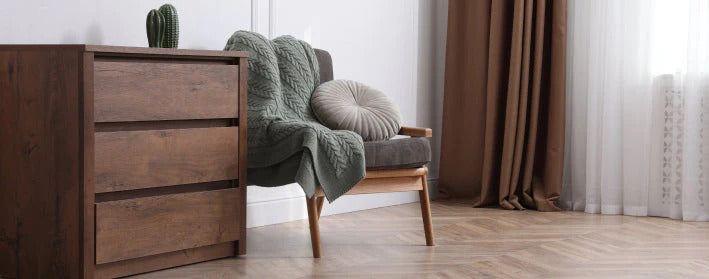The Konig Prestige Mocha Oak laminate herringbone flooring combines traditional elegance with the durability and practicality of modern laminate. Designed to capture the natural beauty of wood, this collection gives you the timeless look of real oak with all the benefits of easy maintenance, long-lasting performance and a quick click-fit installation system.
Mocha Oak stands out with its rich dark tones that bring warmth, depth and sophistication to any interior. This versatile shade works beautifully in both period properties and contemporary homes, adding a touch of luxury while maintaining a homely atmosphere. Its authentic herringbone design enhances living rooms, kitchens, dining areas, hallways and more, making it a stylish yet practical choice for Irish households.
Durable and easy to maintain, Mocha Oak requires little effort to keep it looking its best, even in busy family homes. Its robust finish is designed to handle everyday life while retaining the elegance and character that makes herringbone flooring so desirable.
At Wood Floor Store we offer fast nationwide delivery throughout Ireland, making it easy to transform your home without delay. You can also visit our Dublin showroom to experience the Konig Prestige Mocha Oak in person, explore the full collection and pick up free samples to help you find the perfect floor.
Choose Wood Floor Store for stylish, durable and versatile laminate flooring in Ireland, combining timeless design, modern practicality and exceptional value.
1. Does the floor come in separate boards or is it just a design?
The Herringbone range comes in separate boards to ensure an authentic look
2. How would you clean this floor?
We would recommend cleaning this floor with a lightly damp mop.
Would this floor be suitable for pets?
Yes, this floor is extremely suitable for households with pets due to its AC5 rating
What does AC5 rating mean?
An AC rating refers to the level of wear and tear a floor can endure. AC5 means it is perfect for heavy domestic or light commercial settings.
How much floor should i order to ensure i have enough?
For our herringbone floors, we would recommend adding on 10% to the area you are covering to account for waste.
Does this floor require an underlay?
Yes, all laminate flooring require underlay. we have a number of underlay available to suit any need.
Site prep, subfloor and underlay
Remove all furniture from the room, brush and vacuum the sub-floor.
If you are laying onto a new concrete sub-floor, check that it is fully dried which can take anywhere from 2 - 4 months.
Expansion Gaps
It is vital to leave a consistent expansion gap of 7-10mm at walls, pillars, stairs, doorways and other fixed objects or boarders in the room such as kitchen islands or fitted wardrobes. When drilling a hole for pipes, the hole should be 7-10mm larger than the pipe itself. Objects should not be fixed to a floating floor as this prevents the floor from expanding or contracting when needed.
Materials needed:
Tape measure Spirit level Ruler
Pencil
Saw or stanley knife 7 - 10 mm spacers Rubber mallet Underlay
Flooring Pencil
Installation Guidelines
*** These instructions are a guide only. If you are unsure about anything you should refer to the instructions provided with your materials. ***
The preparation to carry out before laying any boards is the same as that with a laminate
straight plank flooring.
•
The laminate herringbone flooring comes with equal boxes labelled ‘A’ and ‘B’. To begin, you will need three A planks and two B planks. It is best to keep these on either side of you as you lay the planks to avoid confusion. To begin working with the planks, take three A planks and place them on your left hand side and two B planks on your right hand side.
•
Click the side of your first B plank into the head joint of your first A plank to form the classic herringbone V shape. It is advised to look up photographs for reference here. The boards should be clicked in at a 12 degree angle and pressed flat. You should check the manufacturer’s guidelines to see what angle that specific brand recommends as all brands have slightly different grooves.
•
To continue, take another A plank and place this against your first A board along its edge to
meet the top corner of your first B board.
•
You should now have a V shape with two A planks on your left attached to one B plank on
your right beginning the pattern as shown in the image below.
•
Take your second B plank and place this into the left of your V shape and click into place.
Take your third A plank and place this one on the right of your V shape and click into place.
•
Take a fourth A plank and click its header joint into place at the nearest exposed corner of
your second B plank.
•
From the bottom left corner of the third A plank, to the bottom left corner of the fourth A
plank, mark a straight line and cut along it with a saw.
•
This will leave you with an inverted triangle. Disconnect the boards, and click back into
place.
•
From the centre of the rear wall, work your way outwards placing your inverted triangles,
leaving a 10mm at the back and side walls.
•
When it comes to fitting the last inverted triangle to the left and right-hand wall. For section a, ensure that you measure the distance and leave a 10mm gap between your flooring and the
wall.
•
For the left-hand , use the distance measured for section a, and mark (right-to-left) on the inverted triangle and cut this section. For the right-hand wall mark (left-to-right) and cut this
section.
•
Your two cut inverted triangles will now slot into place alongside your other inverted
triangles
•
Now comes the following rows. for the first row of boards, work from right-to-left, placing B boards to the left of each inverted triangle, clicking them into place. When it comes to laying your last board, similarly to the previous, take the measurement for section a and mark it on your B plank.
•
Then, cut the measurement for section a at a 45 degree angle to ensure it fits nicely into the
remaining space.
•
Now, glue the board to the inverted triangle to ensure it is sturdy and stable. •
When it comes to the next row of boards, place your A planks to the right of each inverted
triangle clicking them into place.
•
Make sure you continue this method of laying your boards using B boards from right-to-left
and A boards from left-to-right.
•
If you need any more assistance with this you can call our team on 01 840 4458 or email us at hello@woodfloorstore.ie.
























